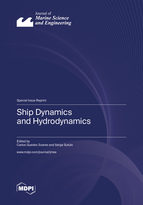Ship Dynamics and Hydrodynamics
A special issue of Journal of Marine Science and Engineering (ISSN 2077-1312). This special issue belongs to the section "Ocean Engineering".
Deadline for manuscript submissions: closed (1 November 2022) | Viewed by 42398
Special Issue Editors
Interests: marine environment; ship dynamics; marine structures; safety and reliability
Special Issues, Collections and Topics in MDPI journals
Interests: ship dynamics
Special Issues, Collections and Topics in MDPI journals
Special Issue Information
Dear Colleagues,
Ship hydrodynamics and dynamics have always been one of fundamental elements of naval architecture and ocean technology and cover a wide range of topics related to interaction between a ship or other marine structures and the surrounding fluid; analysis of the resulting loads and motions thus provide indispensable inputs for the ship’s strength and design problems. In addition to traditional topics, such as ship resistance, propulsion, seakeeping and maneuvering, the issues related to hydroelasticity, motion control, navigation and guidance, route planning, computational fluid dynamics (CFD), hull form optimization, novel kinds of propulsors and steering devices are also considered. In addition to common surface displacement ships, other kinds of marine craft, submersibles, various ocean structures and platforms often become subjects of investigation.
Most of the mentioned topics have been dealt with at the recent MARTECH2020 Conference (http://www.centec.tecnico.ulisboa.pt/martech2020/) on maritime technology and engineering. Due to of the difficulties associated with the present situation, many potential authors that submitted abstracts to the conference were not able to finish their papers on time, so we hope that this Special Issue may be an opportunity for them but also for all others interested in this subject to submit a paper to this Special Issue.
Dr. Carlos Guedes Soares
Prof. Serge Sutulo
Guest Editors
Manuscript Submission Information
Manuscripts should be submitted online at www.mdpi.com by registering and logging in to this website. Once you are registered, click here to go to the submission form. Manuscripts can be submitted until the deadline. All submissions that pass pre-check are peer-reviewed. Accepted papers will be published continuously in the journal (as soon as accepted) and will be listed together on the special issue website. Research articles, review articles as well as short communications are invited. For planned papers, a title and short abstract (about 100 words) can be sent to the Editorial Office for announcement on this website.
Submitted manuscripts should not have been published previously, nor be under consideration for publication elsewhere (except conference proceedings papers). All manuscripts are thoroughly refereed through a single-blind peer-review process. A guide for authors and other relevant information for submission of manuscripts is available on the Instructions for Authors page. Journal of Marine Science and Engineering is an international peer-reviewed open access monthly journal published by MDPI.
Please visit the Instructions for Authors page before submitting a manuscript. The Article Processing Charge (APC) for publication in this open access journal is 2600 CHF (Swiss Francs). Submitted papers should be well formatted and use good English. Authors may use MDPI's English editing service prior to publication or during author revisions.
Keywords
- ship resistance
- ship propulsion
- seakeeping
- maneuvering
- automated ship steering
- navigation and guidance
- experimental techniques
- CFD applications
- ship aerodynamics and wind loads
- hydrodynamics of SES, hydrofoils
- energy saving solutions
- mitigation of ship motions







